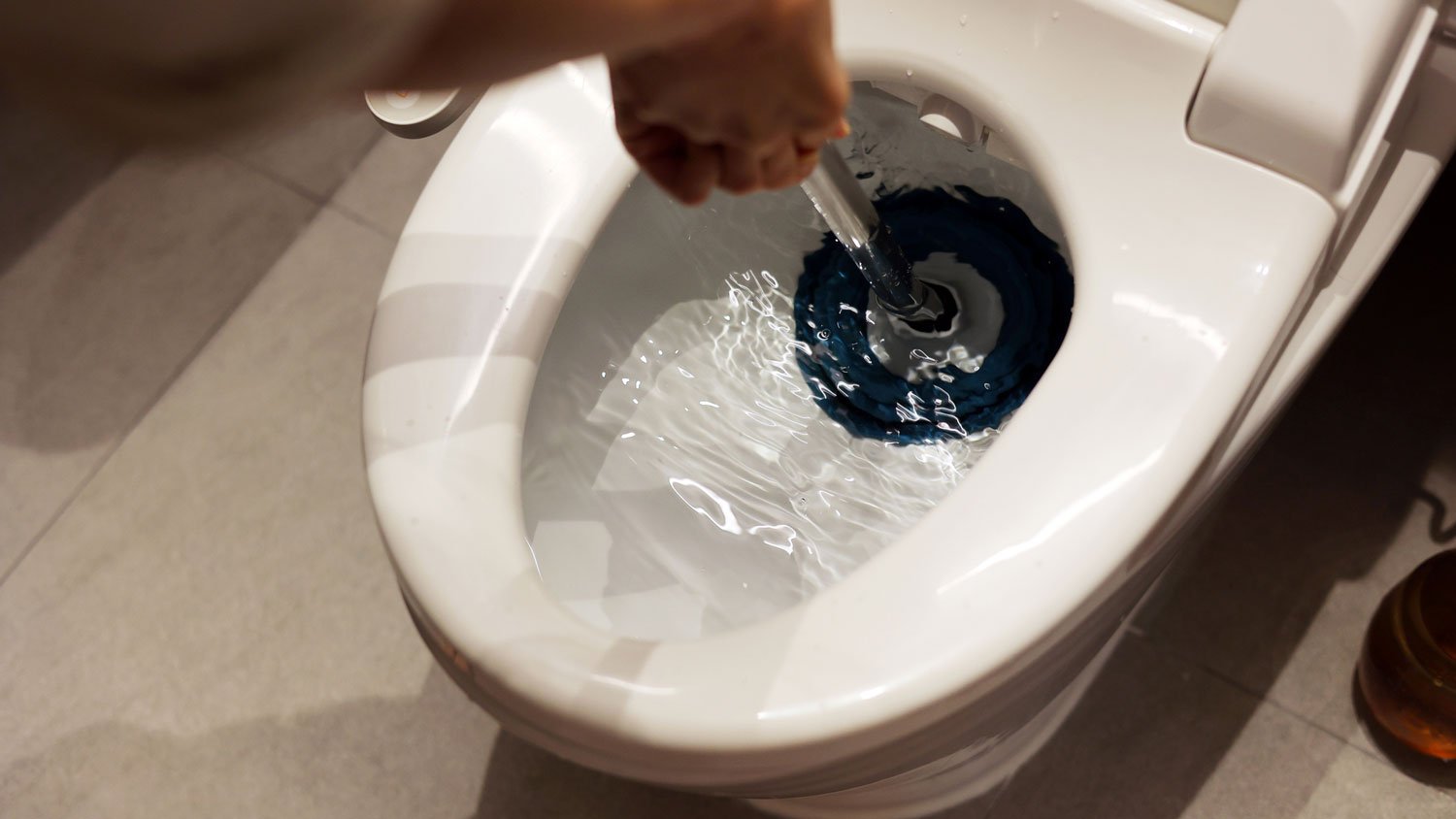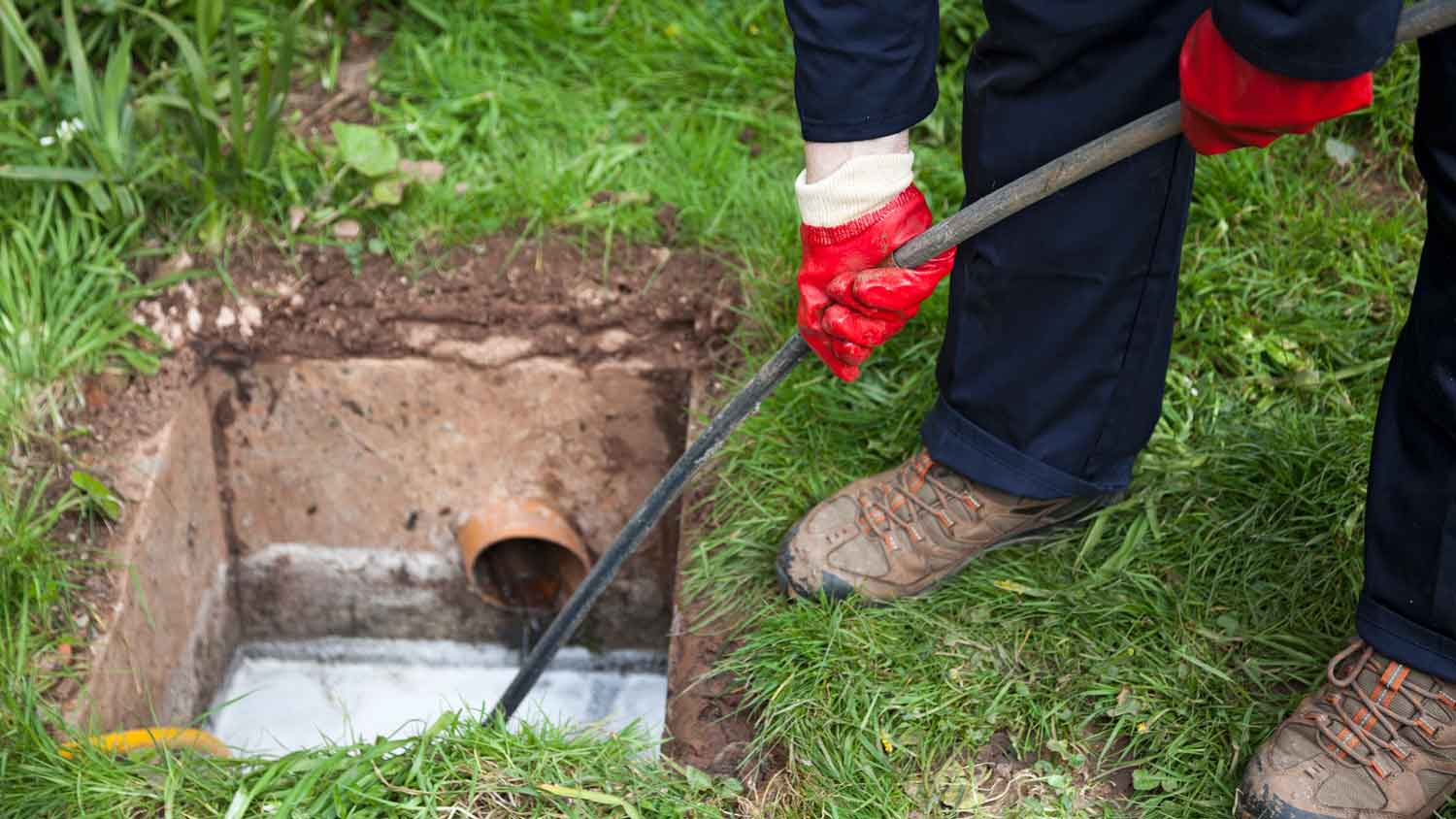
How much does a septic system cost? Explore impacting factors, important add-ons, and how you can save money on septic system installation right here.
Stop smelly, gurgling drains in their tracks


If your drains are making gurgling sounds or emitting a foul odor, there’s probably a clog further down the pipes. This isn’t just a little “icky” or inconvenient—these signs could mean there’s a clog in the main sewer line, and that could point to sludge buildup or even a broken pipe. If you suspect a clog, here’s how to clear a main sewer line clog yourself using different household items.
The main sewer line can get backed up from time to time from sewage and debris. If there’s a broken or leaking pipe somewhere in the plumbing system, it can also allow more dirt and debris in, leading to a clog. If you don’t clear out the clog, it can cause sewage to back up into your drains, leading to foul smells in your home or even flooding in your yard.
The average cost of repairing a main sewer line clog is $380 when you hire a local septic repair pro, but it often ranges between $190 and $570. What you’ll pay depends primarily on the severity and size of the clog, the method of removal necessary, and your pipe’s accessibility. Harder-to-reach pipes will cost more to unclog, as will clogs that are particularly large or stubborn.
So, how will you know when it’s time to unclog the main sewer line? From sewage smells in the drains to a toilet that clogs nearly every time you use it, there are several common signs that there’s a clog in your system.
While you may need to plunge the toilet or use drain cleaner from time to time to get things to flush or drain properly, this shouldn’t be a frequent occurrence. If you find you have to use drain cleaner to unclog the drain nearly every time you wash dishes in the kitchen sink or you have to plunge the toilet after every flush, there’s probably a clog in the main sewer line.
Although the issue may not be so severe that you need to reach for the drain cleaner, slow-draining water in your sinks, showers, or basement drains can also be a sign of a clog.
When you use a sink or flush the toilet, do you notice a gurgling sound coming from the pipes? If so, this is often linked to a clog somewhere further down the pipes. The clog keeps air and water from flowing freely, instead creating pressure that causes the gurgling.
Family game nights might be fun, but no one wants to play What’s That Smell? A clog can cause wastewater to back up into the pipes and up through the drains around the house. Even if you don’t see the wastewater coming back up, you can smell it. It may smell like rotten eggs.
If you have soggy patches around the yard or flooding and there’s been no sign of rain lately, the sewer main line may be clogged, and there is likely a leak in the pipes. Rather than trying to clear the sewage line, you should call a sewer service professional immediately to minimize risk of costly water damage to your property.
There are several different approaches you can take to clear a main sewer line clog yourself, and you can even try multiple methods to chip away at the clog. However, if trying a few options doesn’t seem to make a difference, it’s better to call in a pro at that point. If the clog is too difficult to clear on your own, it may be too big for at-home methods. Or, it could be because of a leak in the system, which a pro will need to repair.
Before you do anything else, fill up a kettle or a pot of water and bring it to a boil. Then, pour the boiling water into your drain a little bit at a time over five to 10 minutes. This method can help melt away clogs of food or other water-soluble grime stuck in the line.

A plunger may be just the ticket to clear pipes. Use the plunger over the drain or toilet that is showing signs of a clog. This method will work best for clogs that are close to the surface of the drain, but it may not be effective for clogs deeper down the line. You may also want to combine the plunger method with other options, such as following up boiling water with plunging.
Another option to clear the clog can be found right in your kitchen. Open the pantry and grab some vinegar and baking soda to unclog a toilet or drain. Mix about 1/3 cup of baking soda and 1/3 cup of vinegar in a large container, and once they start fizzing, pour them into the drain.
This method can be even more effective at clearing a clog when you follow it up with boiling water. Wait about one hour after pouring in the vinegar and baking soda, then use the boiling water method.
Similarly to vinegar and baking soda, salt and baking soda are a powerful clog-clearing combo. Combine one part salt to two parts baking soda, then pour it into the drain. Let this duo work its magic for a few hours, then follow it with the boiling water method.
You can clear a clog with a wet/dry vacuum. To do so, remove the drain plate or stopper so that you have a clear opening into the pipe. Block the sink overflow pipe, then place a wet cloth over the drain opening. Put the end of the hose on the wet/dry vacuum, which should be switched to its “liquids” setting, and against the wet cloth and drain, which will form a tight seal.
The vacuum should suck up debris from the drain that may be contributing to the clog. But once you turn off the vacuum, make sure to slowly pull it away from the drain. You created a tight seal, but removing the hose too quickly can cause the pressure to crack the pipes.

For deeper clogs, you may need to get a snake or auger to reach the buildup. You can use a snake to clear out drains, but you can also use it on the main sewer line.
Locate the sewer cleanout pipe, which might be near a septic tank or near the main sewer line. If you’ve used septic tank landscaping ideas to hide a septic tank or sewer cleanout pipe, you may find the cleanout pipe near your plants. It usually looks like a white pipe sticking slightly out from the ground. With gloves and work boots on, remove the cap and step away to let any excess water drain away from the area.
Feed the end of the snake into the pipe until you feel resistance, meaning the snake feels slow or is difficult to push further. Stop, then start pulling the snake back out of the drain. You may need to do this a few more times to fully clear the clog or to break up multiple clogs down the main sewer line.
Rinse off the pipe with clean water before replacing the cap.
If you have any concerns or questions about clearing the clog, or you’ve tried to clear the clog on your own and it’s still there, it’s time to schedule a professional cleanout. The pros can use a plumbing camera to go down the pipes and locate the clog, and they will be able to safely clear out the problem without causing more damage.

Many people expect to deal with a clogged drain from time to time, but a clog in the main sewer line can become a much bigger problem if it damages the pipes. You can keep your sewer line clear with some regular maintenance tasks.
Our drains can collect a lot of gunk each day. From excess soap and skincare products to food crumbs to hair, all of these little pieces can cling to the pipes and each other, leading to buildup in the main sewer line. You can add drain guards to tubs, showers, and sinks to help catch some of this debris.
You can slow the buildup in your drains with regular DIY and professional cleanings. Clean drains yourself weekly and monthly. Once a week, rinse the drains with hot water. Once a month, use baking soda and vinegar to clean the drains around your home. Hire a sewer cleaning pro about once a year to two years for a thorough cleaning of the main sewer line.
The only things you should flush down the toilet include human waste, toilet paper, and water. Make sure the entire household is on the same page here and that everyone knows not to flush menstrual products, paper towels, wet wipes, or other products down the toilet. These items can clog up the main sewer line.
Baby wipes and other “flushable” bathroom wipes are often not able to properly break down in your septic system. Avoid flushing any wipes down the toilet, even if they say “flushable.”
Regular inspections will help you catch any minor issues before they become major problems. You should schedule a sewer inspection once per year to check for clogs, corrosion, cracks, or other signs of wear and tear.
If you’re dealing with a minor clog, you can typically spend $25 or less to clear it with boiling water, baking soda, vinegar, or commercial drain cleaner. For bigger clogs, you could spend $30 to $300 to purchase a snake, auger, or wet/dry vacuum capable of clearing the clog.
By comparison, the cost to clear a main sewer line clog with professional help is about $1,300 to $4,950, depending on the size and depth of the clog. This process may involve a video inspection to find the clog, tree root removal to remove trees that are growing into and breaking pipes, and hydro jetting the pipes to thoroughly clear the clog.
For bigger clogs, it’s best to hire a local sewer cleaner, especially if you notice flooding in your yard or basement drain. It’s one thing to clear out a small clog of food just below the kitchen sink drain using a snake or some drain cleaner, but the main sewer line is much harder to access on your own. Not only that, but if you make a mistake, you could then have to pay much more to repair broken pipes or fix water damage.
From average costs to expert advice, get all the answers you need to get your job done.

How much does a septic system cost? Explore impacting factors, important add-ons, and how you can save money on septic system installation right here.

The average cost to connect to a public sewer line in Columbus, OH, depends on the linear footage, piping material, local regulations, and more.

Size, materials, and labor all determine the costs of an ejector pump replacement. Follow this guide to help you find the right ejector pump for your budget.

How long do septic tanks last? It’s a valid question for those who have one. The answer is it varies between 15 and 50 years, depending on several factors.

Learn how to test a septic drain field to ensure it’s functioning properly before encountering costly issues.

Your lot might require an alternative septic system based on location and soil conditions. Learn all about alternative septic systems and their costs.